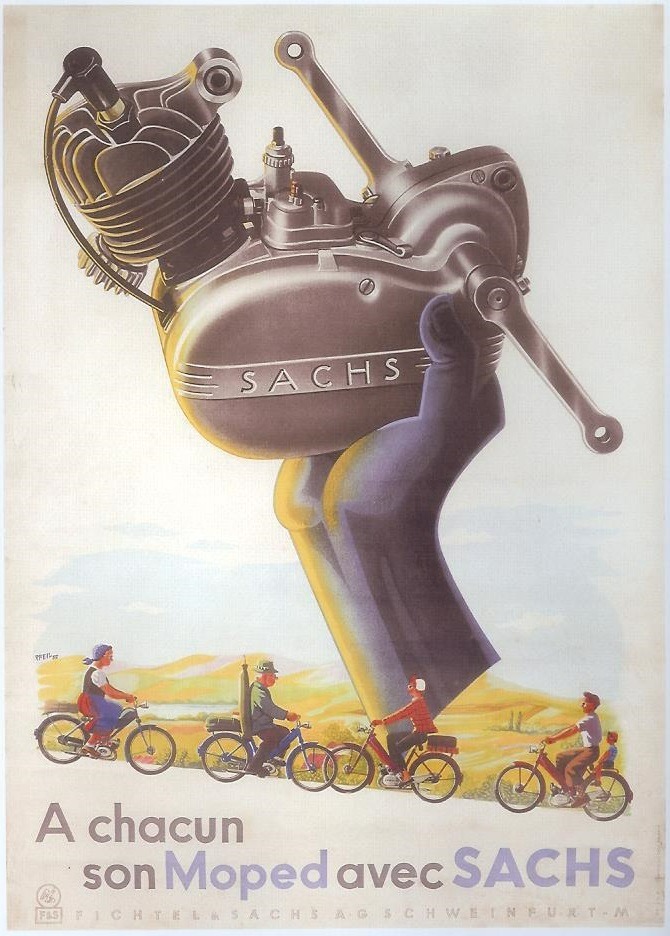The Sachs Saxonette Moped: Two Wheels, One Icon
This article discusses the history of Sachs, a German company that started by manufacturing hubs and spindles for bicycles and lorries in 1895. Over the years, Sachs shifted its focus to the production of vehicle engines, clutches, and shocks and dampers, becoming a key player in the automotive industry. The article highlights the iconic Saxonette moped introduced in 1937 and the challenges faced by Sachs, including a disruption in engine production and legal disputes. Despite these hurdles, Sachs continues to be a prominent brand in the automotive world, combining its bicycle roots with automotive innovation.
CLASSIC MOPEDSSACHS GERMANY 1960'STWO STROKE
11/1/20232 min read


The Marvelous Journey of Sachs: From Bicycles to Motorcycles and the Famous Saxonette Moped
Introduction
Let's take a ride through history and explore the incredible journey of Sachs, a name synonymous with innovation and mobility. From its humble beginnings as a bicycle manufacturer to becoming an automotive legend, Sachs' story is a fascinating blend of technical wizardry and pioneering spirit.
The Roots in Bicycling
Picture a small town in Germany, the year is 1895. Two visionaries, Ernst Sachs and Karl Fichtel, join forces to create 'Schweinfurter Präzisions-Kugellager-Werke Fichtel & Sachs.' Their mission? Crafting ball bearings and wheel hubs for bicycles. With Sachs, a technical genius and a racing cyclist, and Fichtel, a business maestro, the stage was set for something extraordinary. Early innovations like the 'coaster brake' and the 'free-wheel' laid the foundation for Sachs' relentless pursuit of innovative mobility solutions.
The Shift to Automotive
Fast forward to the 1920s, and Sachs faced an economic crossroads. The company transformed into a corporation in 1923 and made a strategic move by selling its ball bearing division in 1929. This marked a shift towards the automotive industry, focusing on vehicle engines, clutches, shocks, and dampers. Notably, Sachs introduced a lightweight two-stroke engine in 1932, a groundbreaking invention that would soon power countless small motorized bicycles from leading manufacturers.
The Legendary Saxonette Moped
Now, let's zoom in on the iconic Saxonette moped, introduced in 1937. This 60cc two-stroke wonder with 1.2 horsepower wasn't your average moped. What made it extraordinary was its design – the rear wheel and motor were a single unit, a concept so revolutionary it earned the nickname "motor wheel." However, it faced some initial hiccups due to construction issues and the outbreak of World War II. It wasn't until after the war that the Saxonette began to gain the recognition it deserved.
The Rotary Engine Motorcycle
Sachs didn't stop at the Saxonette's success; they ventured into rotary engine motorcycles. The Sachs Hercules W2000, produced from 1974 to 1975, was the world's first motorcycle with a Wankel rotary engine. This engine boasted a 160 cm³ displacement, air-cooling, and innovative features like an axial fan for optimal cooling. The engine initially required pre-mixed fuel and oil, similar to two-stroke engines, but later models incorporated oil injection for lubrication. Sachs' foray into rotary engine motorcycles left an indelible mark, inspiring other manufacturers to explore this remarkable engine design.
The Modern Transformation & Success
As the decades rolled on, Sachs underwent significant transitions. After Ernst Sachs' passing in 1932, the company became Fichtel & Sachs AG in 1936. In 1987, Sachs was acquired by the American concern, Mannesmann Rexroth Corporation, and in 2001, ZF Friedrichshafen took over. Today, Sachs stands as a prominent supplier of automotive parts, a testament to Ernst Sachs' legacy of innovation and his impact on the world of mobility.
